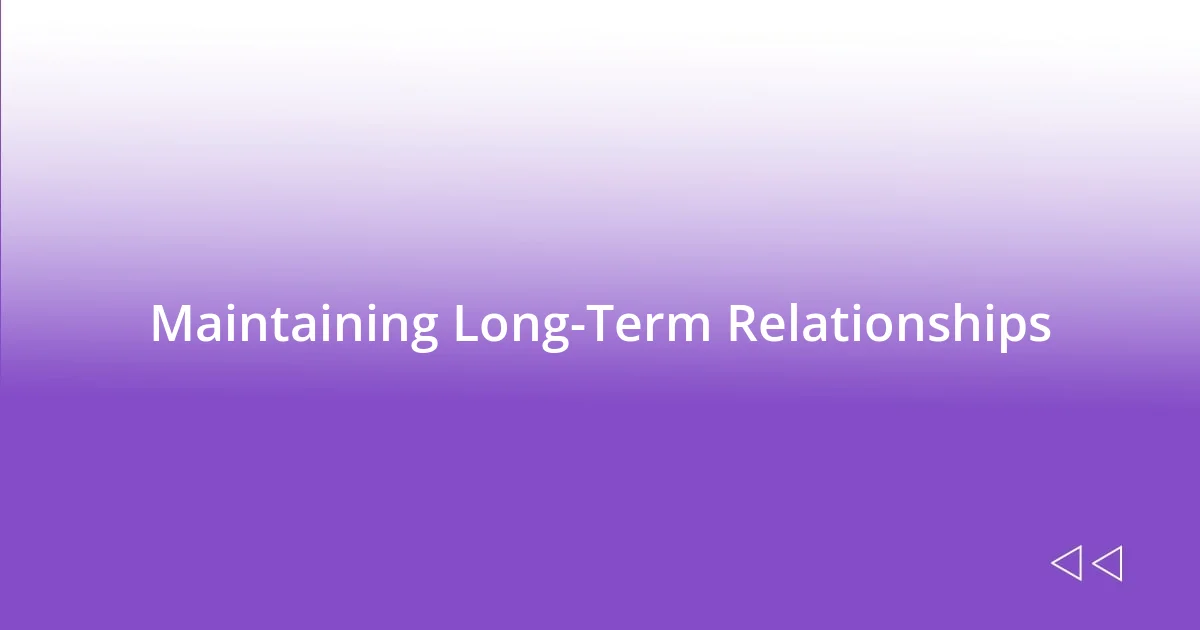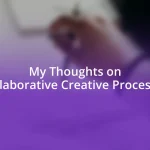Key takeaways:
- Trust and open communication are essential for nurturing collaborative relationships, enabling team members to feel safe sharing ideas and fostering innovation.
- Setting clear, shared goals enhances alignment and motivation among team members, encouraging a sense of ownership and active participation.
- Celebrating successes, both big and small, reinforces teamwork and deepens connections, creating a positive environment that supports future collaboration.

Understanding Collaborative Relationships
Collaborative relationships thrive on trust and open communication. I recall a project where my team was struggling to meet a deadline, and instead of pointing fingers, we gathered for a heart-to-heart discussion. This vulnerable moment turned a stressful situation into a bonding experience, showcasing how honesty can strengthen collaboration.
When thinking about successful collaborations, I often ponder the importance of diverse perspectives. Have you ever noticed how a mix of skills and viewpoints can spark creativity? In one of my previous roles, we had team members from various backgrounds, and the ideas that emerged were nothing short of exhilarating. It taught me that embracing differences can elevate collaboration to new heights.
At the core of a flourishing collaboration lies a shared vision. I vividly remember when I worked with a partner who had a different approach than mine. At first, it felt challenging, but we soon discovered common ground through our shared goals. This experience reinforced my belief that collaborative relationships are not just about combining efforts—they’re about synchronizing hearts and minds towards a common purpose.

Importance of Trust in Collaboration
Building trust within collaborative relationships is essential for creating an environment where team members feel safe to share ideas and perspectives. I remember one instance when a colleague shared a particularly risky idea during a brainstorming session. The atmosphere shifted palpably; instead of dismissing it, we all leaned in, recognizing the courage it took to speak up. This moment not only honored individual input but also reinforced a collective trust that encouraged us to explore even bolder concepts going forward.
Trust influences collaboration in several profound ways:
- Encourages Open Communication: When trust is present, team members are more likely to be transparent and honest about their thoughts and feelings.
- Enhances Problem-Solving: A strong sense of trust allows collaborators to tackle issues together without fear of judgement, leading to innovative solutions.
- Fosters a Supportive Environment: Trust cultivates a culture where individuals feel valued and respected, motivating them to contribute their best work.
- Strengthens Relationships: Over time, trust builds deeper connections, making future collaborations smoother and more productive.
In my experience, the simple act of expressing appreciation can work wonders. I once took the time to acknowledge my teammates’ efforts publicly after a successful project wrap-up. The shared atmosphere of gratitude not only solidified our trust but also created a ripple effect that boosted morale for subsequent initiatives.

Effective Communication Strategies
Effective communication strategies can significantly enhance collaborative relationships. I’ve found that active listening is one of the most impactful tools in my toolkit. During a team discussion about our project direction, I made a conscious effort to listen more than I spoke. This approach not only allowed me to gain valuable insights but also made my colleagues feel heard and respected.
In my experience, asking open-ended questions plays a crucial role in fostering dialogue. For example, when brainstorming solutions, I often ask, “What do you think could work best?” This simple question encourages others to share their thoughts freely, creating a safe space for diverse opinions. By being genuinely curious about my team’s perspectives, I’ve been able to deepen the connection and drive collaboration forward.
Here’s a technique I’ve found effective: summarizing what others have said before responding. I frequently say, “So what I’m hearing you say is…,” before adding my thoughts. This not only clarifies the conversation but also demonstrates that I value my team members’ contributions. It’s interesting how a little reflection can transform communication into a potent tool for collaboration.
| Strategy | Description |
|---|---|
| Active Listening | Prioritizing listening to enhance understanding and rapport. |
| Open-Ended Questions | Encouraging dialogue by inviting diverse opinions and ideas. |
| Summarization | Reflecting on others’ thoughts to validate and clarify communication. |

Setting Clear Goals Together
Setting clear goals together in a collaborative environment is a game-changer. I remember a project where our team sat down to outline our objectives right from the start. Each of us brought our expectations to the table, and by discussing these openly, we aligned our vision. It felt empowering to hear everyone’s voice, which laid a solid foundation for our partnership.
One key aspect I’ve noticed is how shared goals act as a glue that holds the team together. When we agreed on specific, measurable objectives, like increasing our outreach by 25% over three months, it fostered a sense of ownership among all team members. I could see the motivation shift; everyone wanted to contribute actively because we had a common target to rally around. Isn’t it fascinating how clarity can drive engagement?
I often encourage teams to periodically revisit these goals to ensure alignment continues. Once, during a mid-project check-in, we realized one of our targets was no longer relevant due to new developments. Adjusting our focus helped reignite our energy and creativity. It’s a reminder that flexibility is just as important as setting those initial goals—how can you adapt to keep collaboration thriving?

Conflict Resolution Techniques
Navigating conflict within a team can be challenging, but I’ve found that addressing issues head-on is often the best approach. In a recent project, we hit a roadblock when two team members disagreed on the marketing strategy. Instead of letting the tension simmer, I facilitated a calm discussion where both sides could voice their concerns. This not only diffused the situation but also cultivated an environment of respect, ultimately leading to a compromise that combined the best elements of both strategies.
One technique that truly resonates with me is the method of finding common ground. During heated debates, I often encourage team members to refocus on shared objectives. When faced with conflicting opinions on resource allocation, for example, I asked everyone what we all wanted to achieve as a final outcome. Recognizing that we all desired success for the project shifted the conversation from confrontation to collaboration. It’s amazing how a simple shift in perspective can help turn conflict into a constructive dialogue.
Finally, I believe that establishing ground rules for discussions is vital. Reflecting on a session where emotions ran high, I suggested we agree to respect each other’s viewpoints, regardless of disagreements. This set a tone of mutual respect that not only eased tensions but also encouraged more open sharing. How often do we overlook the power of a well-defined framework to protect our relationships? It’s truly transformative and can turn potential conflicts into opportunities for growth.

Celebrating Collaborative Success
Celebrating collaborative success is one of the most rewarding aspects of teamwork. I remember the first time my team completed a project ahead of schedule. After wrapping it up, we gathered for a small celebration to acknowledge everyone’s efforts. We shared our individual contributions, and the collective pride in our achievements created a buzz in the room that was unforgettable. How often do we take a moment to genuinely appreciate what we’ve accomplished together?
It’s not just about the end result, though; it’s about the journey. One significant moment was when we exceeded our expectations by 15%. When I presented our results to the team, I could see each member’s eyes light up with joy. It wasn’t just another statistic; it represented late nights, brainstorming sessions, and relentless dedication. Celebrating milestones, both big and small, reinforces the notion that our teamwork is truly special. Don’t you think it’s these moments that forge deeper connections among colleagues?
In my experience, recognizing collaborative efforts can take many shapes. From a simple shout-out in a meeting to a celebratory lunch, each gesture creates an atmosphere of appreciation. I recall one occasion where we organized a team outing after completing a particularly demanding project. The laughter and camaraderie during that day strengthened our bond and inspired us to tackle future challenges together. Isn’t it fascinating how such celebrations can deepen trust and motivation within a team?

Maintaining Long-Term Relationships
Maintaining long-term relationships requires a commitment to consistent communication and check-ins. I remember a time when I made it a point to touch base with a colleague monthly, just to see how we were both feeling about ongoing projects. This simple act fostered a bond that felt genuine and supportive, allowing us to share not just work updates but also our personal challenges and victories. How often do we pause to ask ourselves if we are truly connected with those we collaborate with?
Trust is the foundation of enduring relationships, and it takes time to build. During a particularly demanding period, I shared my struggles with a team member regarding workload and deadlines. Her willingness to listen and offer help not only alleviated my burden but also deepened my trust in her. These moments of vulnerability create a rich tapestry of shared experiences, don’t you think? They can transform colleagues into allies, fostering loyalty that withstands the test of time.
I’ve found that showing appreciation regularly solidifies long-lasting relationships. For instance, I made it a habit to send a small, handwritten thank-you note after a successful collaboration. One time, a colleague expressed how my note made her feel valued in a hectic work environment. This simple gesture reminded me of the profound impact gratitude can have. It’s incredible how maintaining this culture of thankfulness can uplift spirits and rejuvenate passion for our collaborative endeavors, creating bonds that last well beyond the current project.














